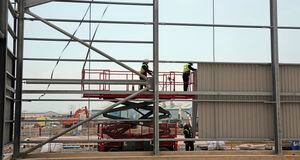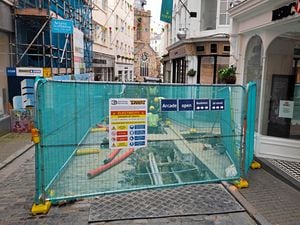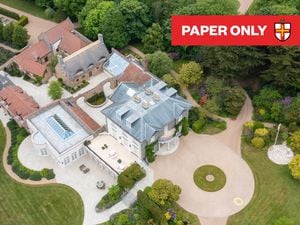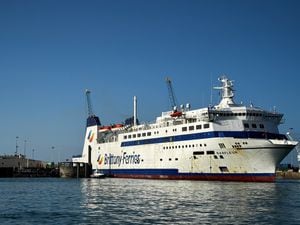'Eyesore? An incinerator would have been three times bigger’
LONGUE HOUGUE’S new waste management facility might be seen as an eyesore by some, but it is about one-third of the height of the incinerator that might have gone on the same site, Deputy Charles Parkinson said yesterday.

The States’ Trading Supervisory Board president was joined by representatives of project manager Amec Foster Wheeler and contractor Geomarine as the media were given a chance to see how work on the new facility was progressing.
Once completed, the building will house three waste handling streams dealing with glass, general refuse and food waste.
Geomarine deputy project manager Gary Stevenson said progress was on schedule, but with work being heavily dependent on wind speeds it could still be adversely affected by bad weather in the weeks ahead.
‘It’s going to be a challenge over the coming weeks,’ said Mr Stevenson, ‘but we will do our utmost to maintain the schedule.’
Geomarine has undertaken several projects over the years, but he said this was among the biggest and was probably on the same scale as the work it did on the commercial quay in Alderney.
The steel frame of the new 40m x 80m building is now complete and work has started to add the outer cladding.
Installation of the roof beams could take place only when the wind was below 20mph (force four) and this also dictated progress on the upper level of the cladding. Yesterday’s wind was strong enough to mean that only lower cladding work could be done.
On the interior ground level, the site is ready to have special slabs added.
These will consist of concrete mixed with microsilica, which Mr Stevenson said made it resistant to abrasives and chemicals.
He did not think this sort of material had been used anywhere in the island before.
While wind has been a problem, one problem that Mr Stevenson was expecting to arise did not – underground water.
‘We normally have to pump to get the water levels down,’ he said.
‘I was expecting to see tidal movement here, but I haven’t.’
The site is on land reclaimed using non-putrescible hardcore waste and because of the dense clay-like nature of the topsoil there has been no problem with underground water, he said.
‘It’s all been sitting on the surface, it’s just been difficult to keep the site clean.’
The building was designed by Amec Foster Wheeler, whose construction manager, Dave Theakston, said that the company had previously worked on large projects in the UK.
‘Progress is going quite well,’ he said. ‘Amec is really pleased with the way things are going.’
He said the machinery that will handle the processing is due to arrive in July or August and will be installed by specialists.
Deputy Parkinson said this was the first time he had been to see progress on the development and he was pleased. ‘We’re slightly ahead of schedule,’ he said.
Looking to head off criticism of the building and its location, he said ‘this was really the only place’ for it to go.
‘All I would say to people who are saying it’s a big eyesore is that the Lurgi incinerator would have been three times as high, with chimneys on top,’ he said.
While stacks will be installed on the roof of the waste management facility, these will be for the building’s air handling units.
Although the facility will not be in operation until next year, STSB will be sending out food waste
caddies later this year and encouraging islanders to start using them.
It is estimated that when it is operating at full capacity, the facility will handle some 1,800-2,000 tonnes of glass waste each year, about 4,000 tonnes of food waste and 26,000 of general waste.
While the food will be mashed up and put into silos for onward transport to an anaerobic digester facility, the island’s general waste will end up in bales of about 1m square, be wrapped up and then shipped to the UK for onward transport to an incinerator.





